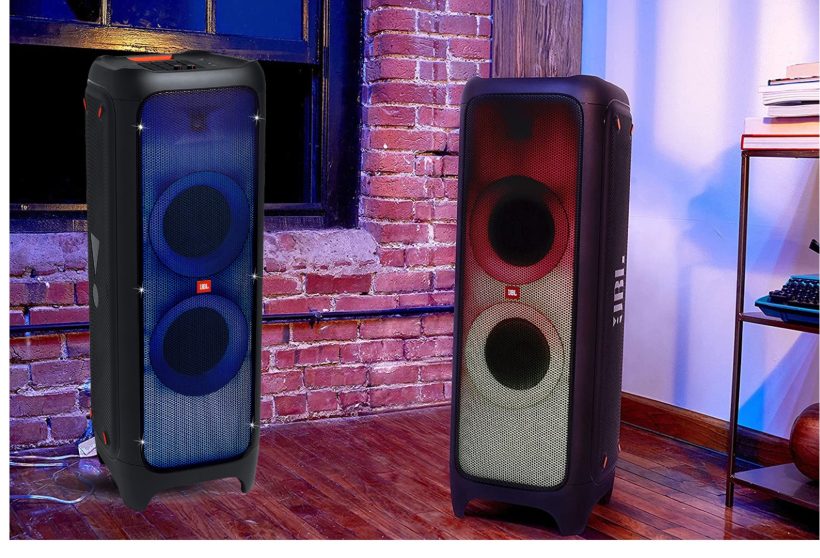The JBL PartyBox 1000 is the loudest JBL speaker ever created to date by JBL and delivers a massive 1100 watts of output power with really powerful bass response. Compared with the other JBL PartyBox speakers such as the PartyBox 710 and 310, the PartyBox 1000 dwarfs them all in terms of pure size and power – it can even deliver much more powerful and punchy bass as the JBL PartyBox 710 and can go all the way down to 30 Hz, which is slightly lower than the PartyBox 710’s 35 Hz range. This makes the bass on the JBL PartyBox 1000 incredibly powerful and has plenty of depth – at maximum volume, it is power enough to make the entire concert floor vibrate with rumbling bass that you can litrally feel to your chest. The PartyBox 1000 has a maximum power output of 1100 watts, which is equivalent to the power output of eight JBL Boombox 3 speakers put together in one single speaker. This gives you a sense of how much massive volume the PartyBox 1000 can produce.
Apart from the staggering volume output, the PartyBox 1000 also surpasses the PartyBox 710 and 310 in terms of specs and design. Unlike the PartyBox 710 or the 310 which has two woofers, the JBL PartyBox 1000 has a dedicated 12” subwoofer attached to the speaker to deliver some of the deepest and most powerful lows you will ever hear. It is as though you have both an integrated speaker and a subwoofer in one system in the PartyBox 1000. The PartyBox 1000 also features two 7” full-range drivers, which are way larger than any dual tweeters (2.75” in the PartyBox 710 and 2.5” in the PartyBox 310). This means that the PartyBox 1000 is capable of delivering much louder sound with brighter highs and clearer vocals. Finally, it should be said that the JBL PartyBox 1000 has the widest frequency response out of all three PartyBox speakers from 30 Hz to 20 kHz, compared to the PartyBox 710’s lowest range of 35 Hz and the 310’s lowest range of 45 Hz. This extra low frequency range makes an appreciable difference in terms of the sound quality and you can really hear how tight and punchy the bass is on the PartyBox 1000 with plenty of depth. Listening to the PartyBox 1000 feels like you are listening to a set of high-end speakers with a subwoofer together in one.
Having said that, although the JBL PartyBox 1000 comes with numerous features which outshines the PartyBox 710 and 310 in terms of power output and better specs, both the PartyBox 710 and 310 are IPX4 water-resistant which makes them easier to bring outdoors, while the PartyBox 1000 does not have any water-resistance or dust-resistance. This means that you can’t bring the PartyBox 1000 to a pool party or beach party as it does not have the proper protection; it is best suited for dry outdoor use on a stadium or a large outdoor concert value where there is shelter from rain. This is one of the factors that you should consider if the JBL PartyBox 1000 is suited for your listening needs depending on the kind of environment you would use it in.
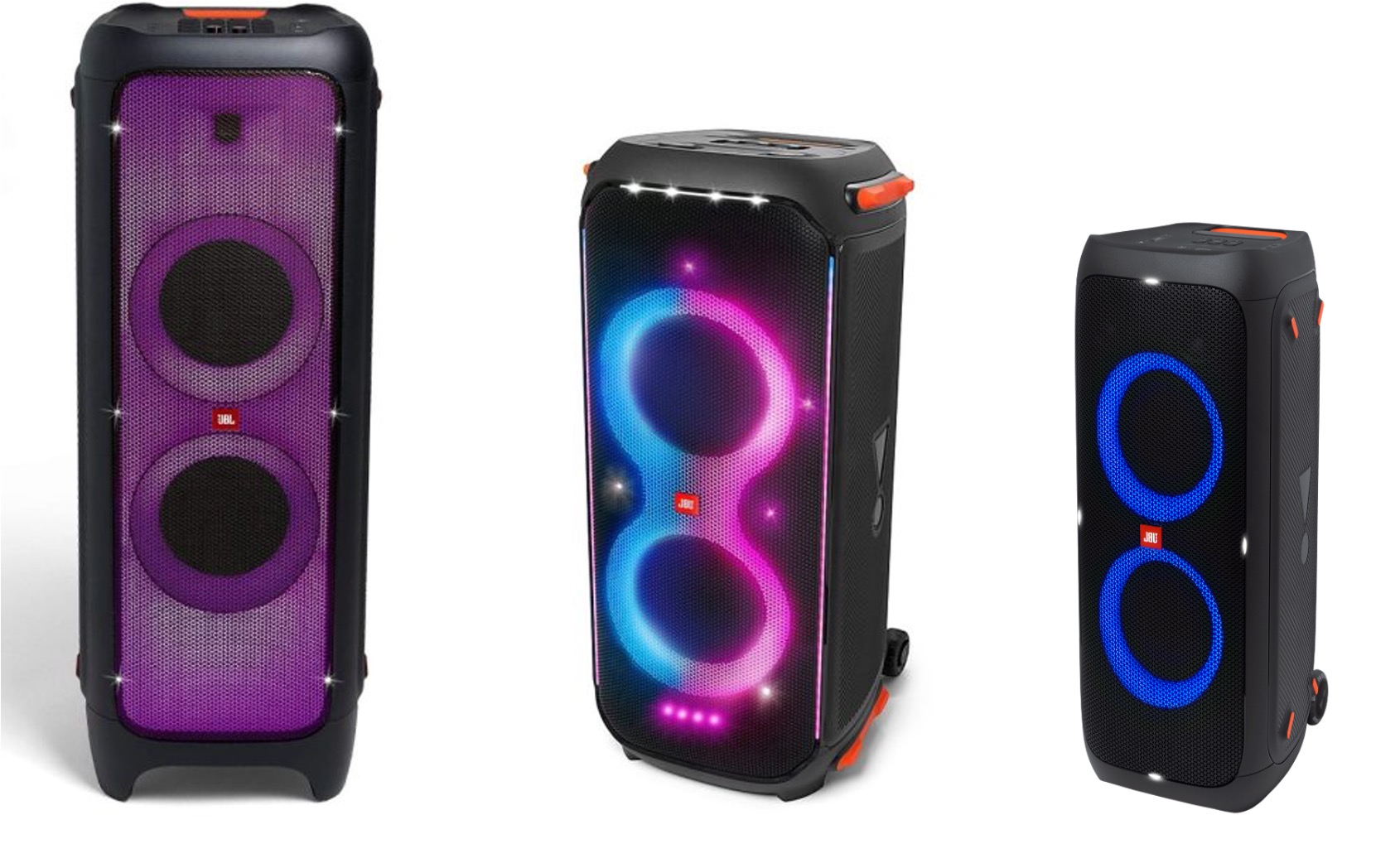
Sound Performance
We tested out the sound performance of the JBL PartyBox 1000 together with the PartyBox 710 and 310 speakers. At close to 30% volume output, all the PartyBox speakers seem to deliver the same audio quality with crystal clear highs, detailed midranges and decent bass that sound punchy and tight, especially from the PartyBox 710 and 310 speakers. However, when you turn up the volume to 70% volume level, the JBL PartyBox 1000 starts to really shine and it can deliver much louder and booming bass, while the other PartyBox speakers start to sound recessed and overpowered at peak bass. The PartyBox 710 and 310 does start to distort closer to 80% volume level, but the JBL PartyBox 1000 sound much louder than any of these speakers at that volume level and still maintains the same level of consistent in the bass output.
The bass on the PartyBox 1000 is extremely powerful and deep, and is something that needs to be heard in order to truly understand how deep it can go. We played a couple of EDM and hip-hop music perfomrances through the PartyBox 1000 and the difference in sound quality was almost instantly noticeable – the bass goes tremendously deep with plenty of depth, and you can hear deep low-end beats down to 35Hz which you might not have expected from a portable PA speaker system. The PartyBox 1000 sounds more like a high-end subwoofer that punches out a tonne of bass that can really get the party going, and is the kind of speaker that you would bring into an area just to jumpstart a party and get the music going. In terms of loudness, nothing comes close to the JBL PartyBox 1000’s 1100W power output level – it is even louder than the JBL PartyBox 710 and delivers much more powerful bass – almost as though you are listening to a fully setup speaker system.
While the bass on the JBL PartyBox 710 and 310 does taper off significantly >75% volume level, the JBL PartyBox 1000 maintains consistent and solid bass output until 90% volume level before tapering off. The bass is extremely strong and powerful, and surprisingly does not sound distorted or muddied even at high volume levels. Everything on the PartyBox 1000 sounds controlled, detailed and has plenty of depth without any harshness in the highs or feel recessed in the midranges. Furthermore, the JBL PartyBox 1000 has the added advantage of providing a DJ launchpad which allows you to play drums, keyboards and piano, and record on the fly while using this speaker as a party speaker. The PartyBox 1000 also comes with microphone and guitar inputs which allows you to use the PartyBox 1000 as a PA speaker system and take the stage.
In terms of sound performance, the JBL PartyBox 1000 is hands down the loudest and most bass-heavy JBL speaker we have tested that out-performs the JBL PartyBox 710 and 310 both in terms of loudness and bass. It is definitely the kind of speaker that you would use if you wanted to power a very large outdoor or indoor concert and require a lot of volume and bass to get the party going. We really liked the fact that the sound performance of the PartyBox 1000 was consistent up to 85% volume level without any hint of distortion and harshness, making it a really good speaker to blast music without losing any noticeable audio quality.
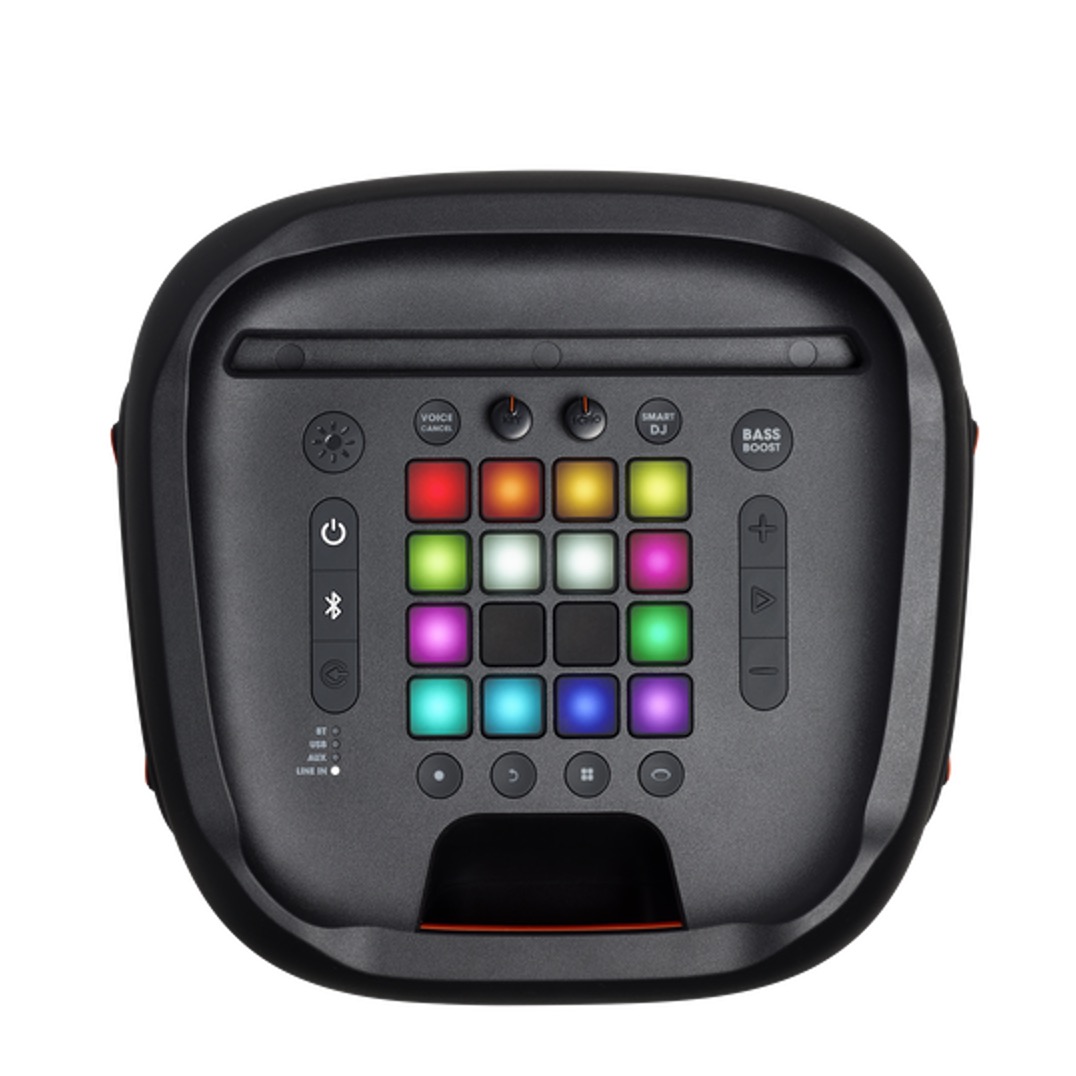
Design and Specs
In terms of design and specs, the JBL PartyBox 1000 is much larger as compared with the PartyBox 710 and 310 speakers. It has a whopping dimension of 39.6cm x 110cm x 38.9cm, making it at least 1.1m tall, compared to the PartyBox 710’s 39.9cm x 90.5cm x 43.6cm and the PartyBox 310’s 32.6cm x 68.8cm x 36.8cm. This means that the PartyBox 1000 almost twice the size of the PartyBox 310 speaker and is the heaviest of all three, weighing in at a massive 76.5lbs, compared to the 710’s 61.3lbs and the 310’s 38.4lb.
All three PartyBox spekaers comes with JBL’s DJ Pad which allow you to play drums, guitars and pinao and record and loop on the fly like a DJ. You can also use the full panel lighting effect which creates a captivating lightshow by turning on the lighting effects in the JBL app. This allows you to sync your music to dynamic customizable strobes which can be easily controlled through the JBL app.
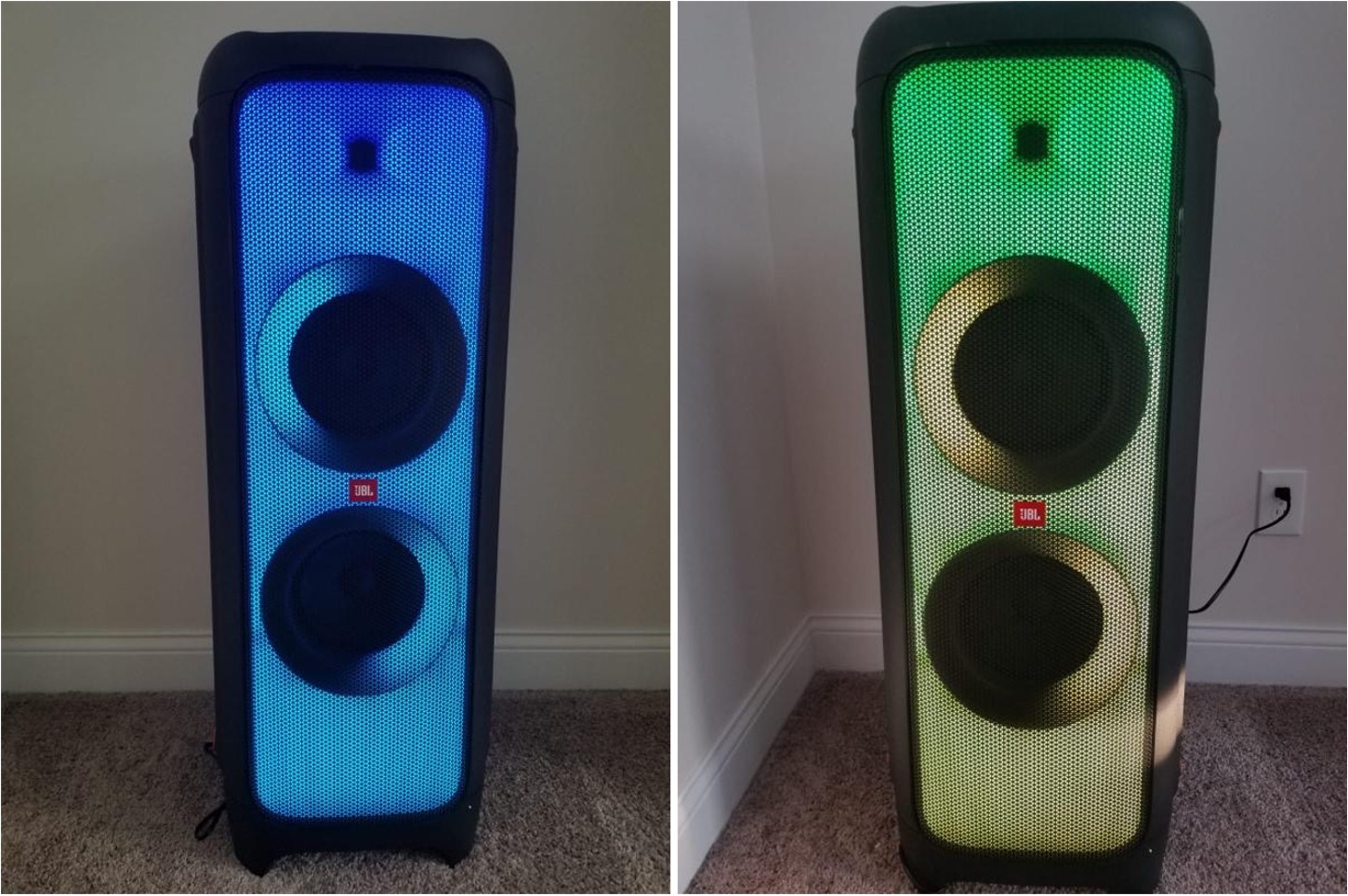
One key consideration to note about the JBL PartyBox 1000 is that is not waterproof or dustproof as compared to the PartyBox 710 and PartyBox 310 which are both IPX4 water-resistant. This means that the JBL PartyBox 1000 can only be operated under dry conditions such an indoor concert hall or stadium. In addition, the JBL PartyBox 1000 requires an active AC power supply to power the speaker through long concert nights, while the PartyBox 310 comes with a built-in battery that delivers up to 18 hours of playtime at 50% volume output. This can be a consideration when deciding whether to get the PartyBox 1000 because it requires active AC power to be turned on; and it cannot be used in areas where there is no access to any AC power such as the beach or pool. All three PartyBox speakers come with JBL’s glided wheels which support easy portability. It should be noted that the JBL PartyBox 710 also comes with a gSport Cargo Sleeve which helps you protect the PartyBox speaker while travelling and also gives you extra pockets for your power cords and accessories.
Finally, we really liked the fact that the JBL PartyBox 1000 supports guitar and microphone inputs which allow you to convert this speaker into a karaoke speaker for outdoor concerts and singing. This speaker supports dual guitar and microphone input options with karaoke EQ tuning and light strobing effects which is perfect for an unforgettable singing experience.
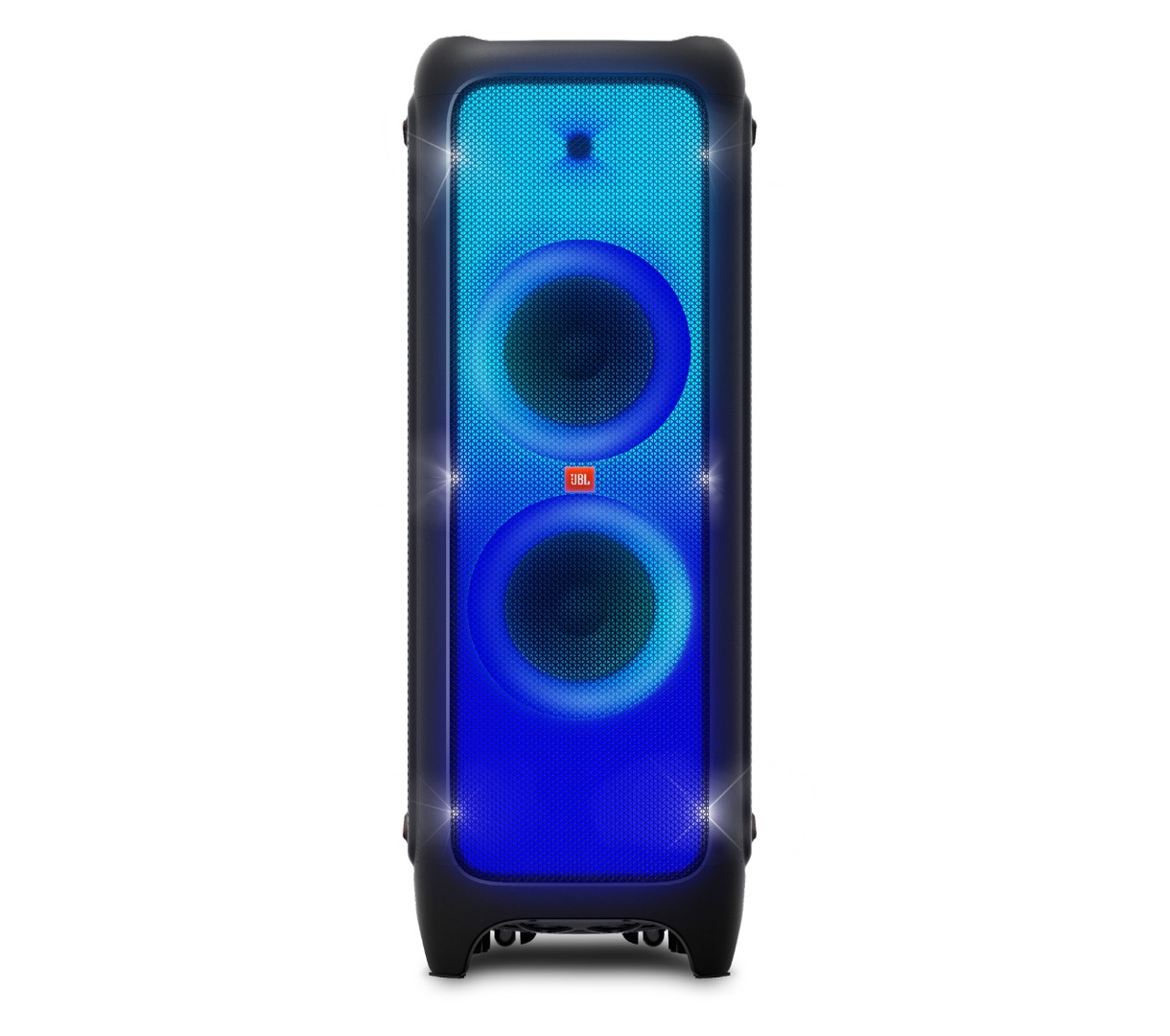
The Verdict?
The JBL PartyBox 1000 is hands down the most powerful JBL speaker ever made with a whopping 1100 watts of output power and extremely deep bass performance. Unlike the the JBL PartyBox 710 or the 310 which has two woofers for bass, the PartyBox 1100 comes with a dedicated 12” subwoofer that it feels as though you are listening to a real-life speaker system with a dedicated subwoofer that delivers really powerful and punchy beats. The bass on the PartyBox 1000 hits especially hard, and they deliver some of the deepest and most immersive sound performance we have heard from a large Bluetooth speaker system. The bass on EDM music sounded very punchy with great depth, and the highs and vocals were also clean and crystal clear. The JBL PartyBox 1000 starts to shine when you push the volume on this speaker over >70% volume level. At that volume level, you get really powerful sound that has plenty of details without any harshness in the upper frequency ranges or muddiness in the bass – everything stays consistently clean and clear, and they soud much louder than both the PartyBox 710 and 310 combined together.
Apart from its tremendous sound output, we felt that the JBL PartyBox 1000 however, does not have the same portability that the PartyBox 710 and 310 has – such as the IPX4 water-resistance capability and the PartyBox 310’s built-in battery which allows it to play music while outdoors. This means that the PartyBox 1000 has to be confined to spaces where there is AC power and where there is no exposure to rain or dust. All three JBL PartyBox speakers are highly portable and can be easily rolled around using the JBL glide roller. Both the PartyBox 1000 and 710 speaker feature guitar and microphone inputs which allow you to transform the speaker into a karaoke speaker with EQ tuning. However, do note that the JBL PartyBox 1000 is the heaviest out of all three speakers at 34.7 kg and it will take substantial effort to carry this speaker around or mount it on a larger vehicle to be transported around.
If you really enjoy listening to loud and punchy music or need the largest speaker you can find for an outdoor event, we highly recommend the JBL PartyBox 1000 speaker. This speaker currently the loudest JBL speaker currently available that delivers a massive 1100 watts of output power with extremely tight and punchy bass. The bass on the PartyBox 1000 comes with a dedicated 12” subwoofer and is virtually unbeatable compared to the dual woofers from the other PartyBox speakers – it punches incredibly low and deep, making you feel like you are in a concert hall. If you do not require the massive volume and bass that the JBL PartyBox 1000 has to offer, we would recommend either the JBL PartyBox 710 or 310 depending on the volume required and ease of portability. The PartyBox 310 on the other hand, is the most portable entry-level PartyBox speaker out of all three PartyBox speakers and even comes with a built-in battery that delivers up to 18 hours of playtime on a single charge, and can also be used to charge your other mobile devices. Both the PartyBox 1000 and PartyBox 710 require nearby AC power and this may affect the locational suitability for using these speakers, and they are unlikely to be used for beach or poolside parties where there is no access to any AC power cord.
On the whole, we would still recommend the JBL PartyBox 1000 speaker due to its sheer size, massive bass reproduction and crystal clear highs and midranges, and its ability to double as a Karaoke system and change the LED dazzling lights on the speaker. This makes the system highly versatile and suitable for any event of any size, and you can push up the volume depending on how much sound you want – it also has a dedicated 12” subwoofer that delivers deep booming bass with plenty of depth, and we highly recommend them over the JBL PartyBox 710 and PartyBox 310 when it comes to sound output.
If you are still deciding between the JBL PartyBox 710 and 310 speakers, be sure to check out our article on the key differences between both the PartyBox 710 and 310 speakers and how to choose the right speaker for your needs.

